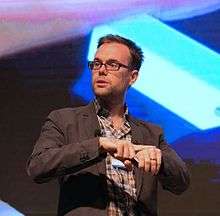Chris Harrison (computer scientist)
| Chris Harrison | |
|---|---|
 | |
| Born |
May 21, 1984 Enfield, London, United Kingdom |
| Residence | Pittsburgh, Pennsylvania, United States |
| Citizenship |
|
| Fields | Human-computer interaction, Wearable computing |
| Institutions | Carnegie Mellon University |
| Alma mater | New York University (B.A., M.S.), Carnegie Mellon University (Ph.D.) |
| Thesis | The Human Body as an Interactive Computing Platform (2013) |
| Doctoral advisor | Scott Hudson |
| Known for | Omnitouch, Skinput |
| Notable awards | Packard Fellow,[1] World Economic Forum Young Scientist,[2] Forbes 30 Under 30 Scientist,[3] TR35 Award[4] |
|
Website chrisharrison | |
Chris Harrison is an English-born, American computer scientist and entrepreneur, working in the fields of human-computer interaction, machine learning and sensor-driven interactive systems. He is an assistant professor at Carnegie Mellon University[5] and director of the Future Interfaces Group[6] within the Human-Computer Interaction Institute. He has previously conducted research at AT&T Labs, Microsoft Research, IBM Research and Disney Research. He is also the CTO and co-founder of Qeexo,[7] a machine learning and interaction technology startup.
Harrison has authored more than 60 peer-reviewed papers, 25 patents, and his work appears in more than 40 books.[8] For his contributions in human-computer interaction, Harrison was named a top Young Scientist by the World Economic Forum (2014),[2] one of six innovators to watch by Smithsonian (2013),[9] a top 30 scientist under 30 by Forbes (2012),[3] and a top 35 innovator under 35 by MIT Technology Review (2012),[4] among many honors. Most recently, Harrison and his students won a Fast Company Innovation by Design Award for their work on EM-Sense.[10] Over the course of his career, Harrison has been awarded fellowships by the Packard Foundation, Google, Qualcomm and Microsoft Research.
Biography
Harrison was born in 1984 in London, United Kingdom, but emigrated with his family to New York City in the United States at a young age. He obtained both a B.A. (2002-2005) and M.S. (2006) in Computer Science from the Courant Institute of Mathematical Sciences at New York University, completing both degrees early. His Master's thesis was advised by Dr. Dennis Shasha, with whom he worked on a relational file system built around the concept of temporal context. New York University honored Harrison as its 2014 Distinguished Young Alumnus.
During his master's studies, Harrison worked at IBM Research - Almaden on an early personal assistance application called Enki under Mark Dean, the then-director of the lab. After completing his master's degree, Harrison worked at AT&T Labs, developing an asynchronous social television platform dubbed CollaboraTV. Encouraged by research colleagues, Harrison joined the Ph.D. program in Human-Computer Interaction at Carnegie Mellon University in 2007, completing his dissertation on "The Human Body as an Interactive Computing Platform" in 2013 under the supervision of Dr. Scott Hudson.
From 2009 to 2012, Harrison was the Editor-in-Chief of ACM's Crossroads magazine, which he relaunched as XRDS, the flagship magazine for the over 30,000 student members of the ACM. Harrison also spun-off several technologies out of CMU to cofound the technology startup Qeexo in 2012, which provides machine-learning based interaction technique software for tens of millions of handsets worldwide as of 2016.
In 2013, Harrison became faculty at Carnegie Mellon University, founding the Future Interfaces Group within the Human-Computer Interaction Institute.
Research
Harrison broadly investigates novel sensing and interface technologies, especially those "that empower people to interact with small devices in big ways". He is best known for his research into ubiquitous and wearable computing, where computation escapes the confines of today's small, rectangular screens, and spills interactivity out onto everyday surfaces, such as walls, countertops and furniture.[11] This research thread dates back to 2008, with Scratch Input appropriating walls and tables as ad hoc input surfaces. Insights from this work, especially the vibroacoustic propagation of touch inputs, led to Skinput being developed while Harrison was visiting Microsoft Research.[12][13] Skinput was the first on-body system to demonstrate touch input and coordinated projected graphics without the need to instrument the hands. This research was followed shortly after by OmniTouch, also at Microsoft Research.
For his research, Harrison has won multiple best paper awards and other accolades. Harrison is also known for his work on post-multitouch input methods for touch screens.
Other activities
Harrison co-developed and is currently co-writing Crash Course Computer Science, a PBS Digital Studios-funded educational series hosted on YouTube. This project was initiated following a discussion between Harrison and John Green at the World Economic Forum in 2016, where both were guest speakers.
Chris is also an amateur digital artist and sculptor. His artworks have appeared in over 40 books and dozens of international galleries. Notable among these appearances were showings of his work at the Triennale di Milano in Milan, Italy (2014), and the Biennale Internationale Design in Saint-Étienne, France (2010).
References
- ↑ "Harrison, Chris". The David and Lucile Packard Foundation.
- 1 2 "Chris Harrison". World Economic Forum.
- 1 2 "30 Under 30 - Science & Innovation". Forbes.
- 1 2 "Innovator under 35: Chris Harrison, 28". MIT Technology Review.
- ↑ "Chris Harrison". Human-Computer Interaction Institute.
- ↑ "About Us". Future Interfaces Group.
- ↑ "About Us". Qeexo.
- ↑ "Most prolific authors in computer science". DBLP.
- ↑ "Six Innovators to Watch in 2013". Smithsonian.
- ↑ "EM-Sense". Fast Company.
- ↑ Harrison, Chris. "Reimagining everyday devices as information-delivery systems". YouTube. World Economic Forum.
- ↑ "Skinput: Appropriating the Body as an Input Surface". Microsoft Research Computational User Experiences Group.
- ↑ "Desney Tan, Chris Harrison on Interacting with Impossibly Small Devices". YouTube. Microsoft Research.